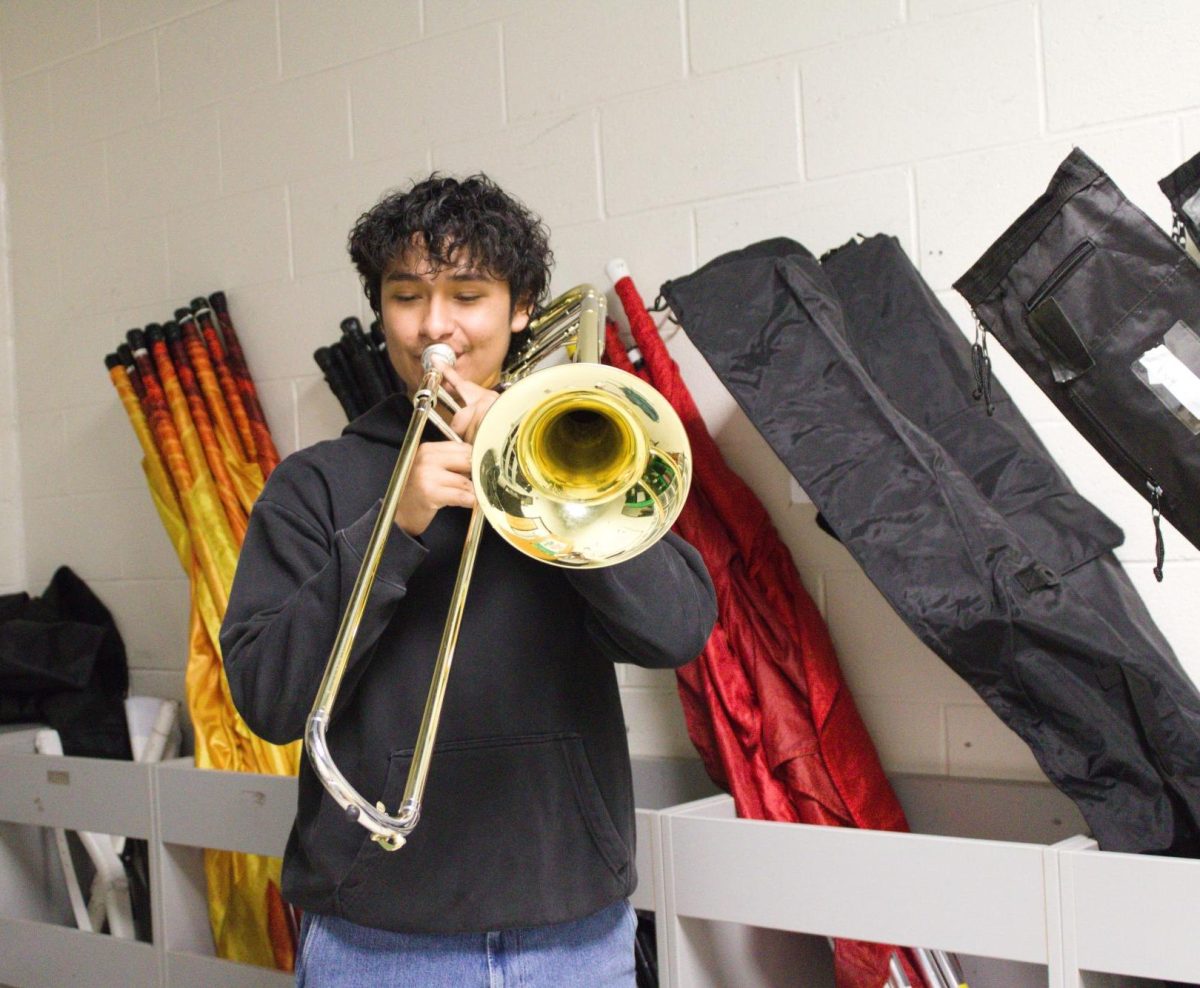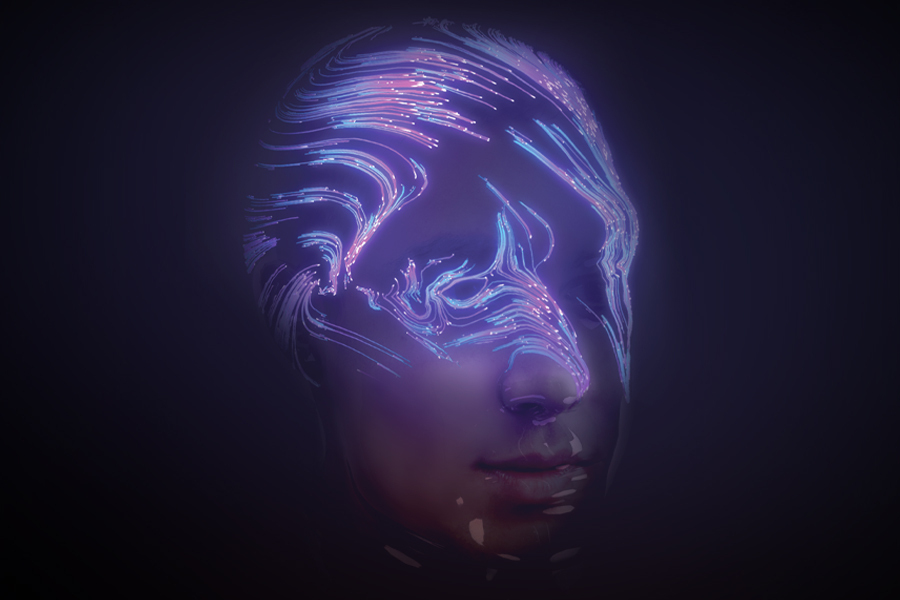Decrypting the future
Artificial intelligence creating new frontiers for education, economy
Srihari Yechangunja
Over the last century, artificial intelligence has grown from simply being a topic in fiction storytelling to a rapidly expanding field that impacts many aspects of one’s life. Due to advancements in AI, including the introduction of ChatGPT in November 2022, there have been debates about its impact being positive or negative with regards to education, the workplace and more.
February 16, 2023
In the early parts of the 20th century, science fiction introduced the world to the concept of artificial intelligence technology, specifically AI robots. It began with Karel Capek and his science fiction play “Rossum’s Universal Robots” released in 1921 where he explored the idea of factory-made artificial people whom he called robots. In 1927, the world saw Metropolis, in which a robotic girl was physically indistinguishable from her human counterpart. 1937, the “heartless” Tin Man from The Wizard of Oz.

The first use of artificial intelligence was during World War II (1940) via the decoding of an enigma machine by Alan Turing, a British mathematician. Ten years later, Turing released a test to test for machine intelligence, but it was in 1955 when John McCarthy coined the term “AI.”
Over the course of the next several decades, more robots were introduced to the world, but it wasn’t until 1997 when DeepBlue (an IBM computer) triumphed over legendary world chess champion Garry Kasporav when people took notice of the new developments and were left questioning how a robot could outmatch and outperform a human.
In 1998, Kismet was created, the first robot that could demonstrate social and emotional interactions with humans. Through vocalizations, facial expressions and other motor capabilities, Kismet had the capability to express various emotions: disgust, surprise, sadness, interest, anger and calmness.
In 2016, the first robot to have citizenship in any country, Sophia, was created. A humanoid robot equipped with artificial intelligence, Sophia can imitate facial expressions, language and form opinions and can get smarter over time.
On Nov. 30, 2022 a new chatbot was released to the public: ChatGPT. Taking the world by storm, it gained one million users in just five days after going public.
ChatGPT is a large language model developed by OpenAI that is trained on a massive dataset of conversational text. It is designed to generate human-like responses to text-based prompts, and can be used for a wide variety of natural language processing tasks such as language translation, question answering, and text summarization.
As with most AI technology, the introduction of ChatGPT to the public has raised some concerns, namely that it can be used for malicious purposes such as creating fake news or impersonating others. Considering the model is based on text data, the model can produce biased or discriminatory outputs and the model may be too accurate when it comes to generating human-like text which lends itself to deep fake attacks.
A University of Minnesota law professor, Jon Choi, told CNN that the goal of the tests was to explore the technology’s potential to help lawyers in their practice and aid students in exams, whether or not it is permitted by professors, as the questions do mimic the writing that lawyers do.
“ChatGPT struggled with the most classic components of law school exams, such as spotting potential legal issues and deep analysis applying legal rules to the facts of a case,” Choi told CNN. “But ChatGPT could be very helpful at producing a first draft that a student could then refine.”
At the Wharton School of Business, ChatGPT earned a B to B- grade in a business management course exam. A Wharton business professor Christian Terwiesch said that the bot did “an amazing job” at responding to basic operations management and process-analysis questions, but had a harder time with more advanced prompts and made “surprising mistakes” with basic math.
A team of researchers found that ChatGPT was even able to pass the U.S. Medical Licensing Exam, exceeding the 60 percent threshold in most analyses. In the instances where the AI underperformed, the team believed that it was, according to IFLScience, partly due to “missing information that that AI [had] not encountered.”

With the variety of uses that ChatGPT offers as a part of the platform, students have begun to increasingly use the platform to aid in their schoolwork: writing essays or short answers, answering questions, writing forms of code, projects and more.
“Even before this ChatGPT started, we have been seeing the effects of technology with different sites that people would send essays to and sharing answers,” Coppell High School IB English III teacher Stephanie Spaete said. “I think it’s been long since coming. I have seen some of this start to show up in some of the responses, even short answers, so it’s a little concerning.”
Because of its popularity and rise, especially seen in English classes or more discussion based/essay writing classes, teachers such as Spaete have had to modify their curriculum and instruction in order to ensure students are still receiving a quality education, one that is not hindered by AI and technology that can potentially do the work for them.
In the case of Spaete’s IB classroom, she has found herself moving more towards a pen and paper environment rather than digital learning. The class itself is heavily focused on reading and discussion and although annotation and writing assignments persist, she has found herself modifying curriculum to where students complete the reading at home and are required to complete the annotations or written component in class to monitor students and ensure their thoughts are being evaluated.
“I think AI skills are hurting students in a number of ways,” Spaete said. “It’s hindering the capability to think critically because you’re using a tool that does all the thinking for you and you’re losing the human aspect or the connections you would make in your own mind. You’re not actually thinking through something, it’s just processed for you. Also, it would create further problems with people’s ability to communicate and later in life, it will end up harming them when they look for jobs and they have to do skills on their own because they won’t be able to have that foundation.”
Although AI technology does present certain challenges with regards to a loss of critical thinking and the human aspect to writing, there are platforms that enable students to learn about topics beyond the walls of the classroom.
“If you are really into a topic and you want to know something specific, if you search it up on Google, going through the millions of search results that are there takes a while, you get bored and you probably don’t want to learn it at some point because you just get bored of searching,” Coppell High School junior Samhitha Kona said. “Now, you can just type it into ChatGPT and it gives you a result instantly. Then, you’re still more immersed in it and then you have more questions. If you’re going more into specifics, you can learn a lot [on ChatGPT].”
Using AI platforms, the outcomes seemed limitless. However the chatbot raises an important concern in a high school setting: the large potential for plagiarism of work. Furthermore, the chatbot creates individualized responses each time the prompt is entered. That aspect of the AI platform creates a unique challenge for instructors to combat as they attempt to differentiate between a student’s writing and the work of ChatGPT.
“[When teachers allow students to use ChatGPT], they’re giving [students] a resource they’re already probably going to use and giving to them and saying ‘use this wisely,” Kona said. “Now [the students] can’t just fully cheat and have ChatGPT completely make an essay for them. I can definitely see how using it in your classroom and saying ‘you can use this as long as you use it wisely’ is better than just saying nothing about it. Then it feels like the students have the upper hand and [this way] the teacher does because they are fully aware about it.”
Using a combination of platforms, ChatGPT can be utilized to create text to prompt videos that can be used as an instructional tool for both teachers and students. Thus, if teachers give a prompt of instruction that explains a topic discussed in the classroom, a video can be generated that students can refer back to when needed to refresh their memory on the topic or simply to understand it better.
“At its current ability level, I would not use it as a teaching tool, but I could foresee in the future that it certainly will improve,” CHS AP Statistics teacher Dr. Lowell Johnson said. “One downside going forward is that right now ChatGPT is free. I expect that’s going to change and that might change what schools do with it because if they can’t access it for free, it might not be something they’re so excited about using. That raises another question about once they start charging for it then it’s going to be a tool that well to-do families can use and poor families will not be able to have access to it so there’s an equity issue there and if we use it in education.”
One of the unique abilities and main uses of ChatGPT has been its ability to write accurate, programmable code. Moreover, ChatGPT can produce code in a variety of languages including C++ and MicroPython. With that unique functionality, AI can therefore serve to reduce the time spent on certain tasks and the money needed. Despite AI not being able to change based on data, it can evolve and that creates better backend processes and better code.
“With early development in reading skills and so forth, there really is a process to learn how to read and write,” CHS AP Computer Science Principles teacher Michael McCabe said. “The same thing goes for using an AI. It’s an easy quick fix or it can be. The kids still need to learn the material. However, I think it could be a useful tool in developing some of those skills.”
Despite the impressive writing capabilities of ChatGPT, there still is, according to CHS teachers, the major differentiation between a human’s writing and ChatGPT’s writing: an actual human-like component to the writing. Although there is that aspect missing, the program is still “creative and its answers can sound downright authoritative.”
“I think we’ll always have to have human beings that know how to discriminate between what’s right and what’s wrong,” CHS Principal Laura Springer said. “I think that a computer can imitate you to a certain degree, but I think that human characteristic, social things that we need to be teaching you, those character traits that we need to be teaching you, a computer can’t do that for you. I’m not afraid of [AI]. I think you can use it as a tool. Let’s use it, let’s let it be a tool to enhance, but let’s not be afraid that it’s going to take over because I do believe we still need that human interaction, we still need those human skills that we need to teach.”
As for CISD schools and buildings, the effect of AI technology remains unclear as platforms like ChatGPT, Grammarly, Mathway and Photomath are still being used, as with any form of technology, room for improvement still stands.
“AI in technology is going to be a game changer, to what extent is still to be determined,” CISD Executive Director of Technology Stephen McGilvray said in an email. “Specific to CISD, the Curriculum and Instruction team will determine what will be incorporated into the classroom and the instructional lessons being taught. [The] technology [department] will be here to support that direction.”

It is Jan. 22, 2018 in Seattle.
Normally welcomed with a greeter, you now encounter a train station style row of gates that guard the door, only allowing people with the store’s app inside.
The 1,800 square-foot store is packed with shelves of food that is typical of other stores. It is not the products that make the store unique. It is the actual shopping experience.
There are no cashiers or registers anyway. As shoppers get ready to leave the store, they pass through the same entry gates without having to pull their wallets out at any point. Rather, as customers place items into their cart, their Amazon account is automatically charged for the products and the opposite applies when products are removed from the cart. Customers are then charged for the products they go home with.
The employees who are working at these stores are tasked primarily with stocking shelves and answering customer’s questions.
As of January 2023, there are 33 Amazon Go stores throughout the United States and 15 in the United Kingdom. But the concept of a store that incorporates AI technology is not necessarily new. McDonald’s, Walmart, Lowe’s, Walgreens, Sephora, Taco Bell, Macy’s and H&M are just a few of the many stores that have begun the transition to implement new technologies in their stores.
The case of Walmart doing away with cashiers in stores to offer “new checkout experiences” for customers via self-checkouts, pickup and delivery provide the perfect example of one of the major concerns when it comes to AI technology. It could replace human workers.
“In economics, we kind of push back on [the idea that AI will replace human workers] quite a bit,” University of Dallas assistant professor of economics Dr. Malcolm Kass said. “While some jobs or trade does disappear because of technology, that just opens up new markets, while maybe in the near term, it’s hard to transition over, eventually people start to take those jobs and we have different job mixes. Once you release this labor supply, there’s other ways the labor supply can be used and they’ll find new ways to use them. We’ve been going down this since the last industrial age for the last 300 years and we have yet to find widespread unemployment because of technology [in the developed world.]”
Despite that fear, Accenture covered 12 developed economies that comprise more than 0.5 percent of the world’s economic output and found that AI could double their annual global economic growth rates by 2035. There are three primary reasons for this type of rapid growth: an increase in labor productivity, the creation of a virtual workforce and the diffusion of innovation.
“[AI] is like most technological innovation, at the beginning there’s some fear because the first thing you immediately recognize is what sorts of functions it will replace,” University of Dallas associate professor of economics and Chair of the Economics department Dr. Tammy Leonard said. “But, as we’ve seen throughout history, with every new technology that enters the workforce, new jobs are created and things change and are modified. I expect it to work out much like we see happening in so many other places in that it’s going to cause a shift in the labor market, but it’s not going to be a net negative, I think it’s going to be a net positive.”
A study conducted by PricewaterhouseCoopers approximates that global gross domestic product could increase by up to 14 percent (around $15.7 trillion) by 2030 as AI is incorporated more and more into the economy and society. But the distribution of those gains is not spread as evenly with North America potentially seeing a 14.5 percent gain ($3.7 trillion) and China would see a 26 percent increase ($7 trillion). On the other hand, Latin America can only foresee a 5.4 percent increase ($0.7 trillion) and Africa, Oceania and others would witness 5.6 percent growth ($1.2 trillion).
“Essentially, we’re missing out on the human capacity in [less advanced] countries,” Leonard said. “In a developed country like the United States, when you have these great wealth gaps it often means that people at the bottom are not able to develop their human capacities. We, as a society, all of us benefit if all the people can flourish and contribute to society. So when we have these growing gaps, one of the negative outcomes is that you miss out on the potential for people at the bottom end of that spectrum.”
In computer science, AI is leading to the development of new algorithms, models and techniques for building intelligent systems. It is also driving innovation in areas such as natural language processing, computer vision and robotics.
In engineering, AI is being used to optimize design processes, improve product quality and increase efficiency in manufacturing. For example, AI is being used to develop predictive maintenance systems that can detect potential equipment failures before they occur, reducing downtime and increasing efficiency.
“Everyone just thinks that AI is going to take over all of these jobs, but in reality the professionals in computer science and engineering careers are the people creating these AIs,” CHS junior Naisha Jain said. “You’re developing these, you have to refine them and constantly make them better. It wouldn’t get rid of too many jobs because they’re always ways to improve a website or the functionality or the aesthetics and that’s the computer science aspect. Computer science is navigation and engineering could include marketing it because that’s part of the engineering design plan, you have to produce, market and sell it to the world.”
Apart from just ChatGPT, other AI powered platforms have existed that have provided tutoring services and homework help for students of all ages including Photomath, Mathway even Grammarly. But those apps have the potential to take business away from physical tutoring services, some of which many CHS students work at.
“Personally when it comes to Gideon, we cater towards younger kids,” CHS Sowbarnika Morsa said. “Our highest math is geometry and our highest reading is comprehension. Typically our age goes from about 4 years to 12 so I don’t think we have as much of an issue with ChatGPT because mostly those tools are used in high school and we have almost no students in high school. I think maybe centers that cater towards older kids who go to high school may be more affected by it because their clients are more likely to use online tools compared to tutoring centers.”
One of the other industries that stands to be affected to a great degree once AI is incorporated into it is the healthcare industry. AI can be used to do claims processing, clinical documentation, revenue cycle management, medical records management and can go as far to improve medical diagnoses.
“If we’re talking AI, they already use robotics in surgeries, I know they’re using AI in that application as well and that’s given us more precise surgeries with less trauma to patient tissues with faster recovery times, so that’s phenomenal,” CHS Medical Assistant teacher Rachel Chesney said. “I just don’t want it to eliminate jobs from real people and eliminate that connection and listening. Artificial intelligence can’t pick up on emotional context and be able to decipher what that means underneath it all. They may be able to understand an inflection in voice that says a patient is upset, but can they help that patient cope? So by having a one-on-one conversation with the patient, you can often pick up on those little nuances and lead with your patient history to try to figure out what’s going on with that patient so you can truly help them. Then that further information helps us to create a better diagnosis. AI can’t do that.”
This story was originally published on Coppell Student Media on February 14, 2023.





































